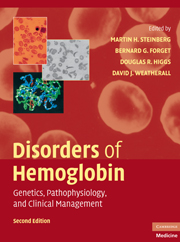Book contents
- Frontmatter
- Contents
- List of Contributors
- Foreword, by H. Franklin Bunn
- Preface
- Introduction, by David J. Weatherall
- SECTION ONE THE MOLECULAR, CELLULAR, AND GENETIC BASIS OF HEMOGLOBIN DISORDERS
- SECTION TWO PATHOPHYSIOLOGY OF HEMOGLOBIN AND ITS DISORDERS
- SECTION THREE α THALASSEMIA
- SECTION FOUR THE β THALASSEMIAS
- 16 The Molecular Basis of β Thalassemia, δβ Thalassemia, and Hereditary Persistence of Fetal Hemoglobin
- 17 Clinical Aspects of β Thalassemia and Related Disorders
- 18 Hemoglobin E Disorders
- SECTION FIVE SICKLE CELL DISEASE
- SECTION SIX OTHER CLINICALLY IMPORTANT DISORDERS OF HEMOGLOBIN
- SECTION SEVEN SPECIAL TOPICS IN HEMOGLOBINOPATHIES
- SECTION EIGHT NEW APPROACHES TO THE TREATMENT OF HEMOGLOBINOPATHIES AND THALASSEMIA
- Index
- Plate section
- References
16 - The Molecular Basis of β Thalassemia, δβ Thalassemia, and Hereditary Persistence of Fetal Hemoglobin
from SECTION FOUR - THE β THALASSEMIAS
Published online by Cambridge University Press: 03 May 2010
- Frontmatter
- Contents
- List of Contributors
- Foreword, by H. Franklin Bunn
- Preface
- Introduction, by David J. Weatherall
- SECTION ONE THE MOLECULAR, CELLULAR, AND GENETIC BASIS OF HEMOGLOBIN DISORDERS
- SECTION TWO PATHOPHYSIOLOGY OF HEMOGLOBIN AND ITS DISORDERS
- SECTION THREE α THALASSEMIA
- SECTION FOUR THE β THALASSEMIAS
- 16 The Molecular Basis of β Thalassemia, δβ Thalassemia, and Hereditary Persistence of Fetal Hemoglobin
- 17 Clinical Aspects of β Thalassemia and Related Disorders
- 18 Hemoglobin E Disorders
- SECTION FIVE SICKLE CELL DISEASE
- SECTION SIX OTHER CLINICALLY IMPORTANT DISORDERS OF HEMOGLOBIN
- SECTION SEVEN SPECIAL TOPICS IN HEMOGLOBINOPATHIES
- SECTION EIGHT NEW APPROACHES TO THE TREATMENT OF HEMOGLOBINOPATHIES AND THALASSEMIA
- Index
- Plate section
- References
Summary
INTRODUCTION
The β thalassemias and related disorders are characterized by a quantitative reduction in the production of β-globin chains of HbA. More than 200 β thalassemia alleles have now been characterized (http://globin.cse.psu.edu) involving mutations affecting any of the steps in the transcription of the β-globin gene, posttranscriptional processing of its pre-mRNA, or the translation of its mRNA into protein. The vast majority of simple β thalassemias are caused by point mutations within the gene or its immediate flanking sequences, although small deletions involving the β gene may also occur. If β-chain production is totally abolished by the mutation it is referred to as β0 thalassemia, whereas reduced output of β-chains (of normal structure) produces β+ thalassemia, with the mildest forms sometimes referred to as β++ or “silent” β thalassemia. These common forms of β thalassemias are inherited as haploinsufficient mendelian recessives.
Some structurally abnormal β-chain variants are also associated with quantitative deficiencies of β-globin chain production and have a phenotype of β thalassemia, in which case they are referred to as “thalassemic hemoglobinopathies,” for example, HbE (β26 Glu→Lys). In others, the β-globin variants are so unstable that they undergo very rapid postsynthetic degradation giving rise to a functional deficiency. These hyperunstable β-chain variants act in a dominant negative fashion, causing a disease phenotype even when present in the heterozygous state, and hence have been referred to as “dominantly inherited β thalassemia.” β Thalassemia mutations that segregate independently of the β-globin cluster have been described in occasional families.
- Type
- Chapter
- Information
- Disorders of HemoglobinGenetics, Pathophysiology, and Clinical Management, pp. 323 - 356Publisher: Cambridge University PressPrint publication year: 2009
References
- 32
- Cited by

